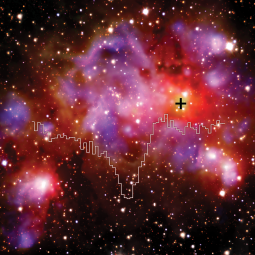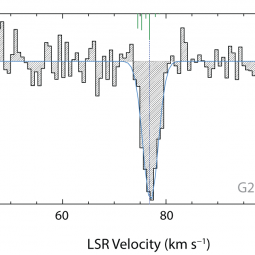By Timea Csengeri and Joan Schmelz
Paper:
SOFIA/GREAT observations of OD and OH rotational lines towards high-mass star forming regions
Csengeri, T., et al., 2022/02, A&A, 658A, A193.
Water is one of the most important molecules in the processes that govern star and planet formation. Although the relative importance of its creation and destruction mechanisms in the interstellar medium are still debated, the large water content of the Earth’s atmosphere limit direct measurements of its abundance variations. Fortunately, observations of the hydroxyl radical, OH, can constrain chemical pathways leading to the production of the water molecule. In addition, tracing the deuterated form, OD, can place constraints on the chemical formation routes by measuring the quantity of the enhancement of deuterium-containing molecules in the star-forming gas. The OD/OH ratio is also an important probe since it may reflect the physical conditions and the chemical evolutionary state of the gas.
Rotational transitions from the OH and OD molecules lie in the THz band and can be probed with the German Receiver for Astronomy at Terahertz Frequencies (GREAT) instrument onboard SOFIA. Previous observations of OD absorption were limited to a single source, but results from this work have added 13 new OD detections toward a wide variety of galactic targets, including cold quiescent clouds as well as more evolved regions with ionizing OB type stars. Researchers aim to constrain the OD abundance and infer the deuterium fractionation of OH in the molecular envelopes. Radiative transfer modeling using multiple tracers shows that the OD absorption likely originates from the cold, outer layers of the star-forming gas and seems to be prevalent in massive clumps.
OD is identified toward all evolutionary stages of the targeted sample, suggesting a long lifetime for the molecule. However, data indicate that the OD abundance in the cold dense gas is higher at the onset of the cloud collapse and decreases with time. This is consistent with chemical models predicting that both higher temperatures and stronger radiation fields lead to a more efficient destruction of OD. Due to the radiative feedback of newly formed high-mass stars, such conditions occur towards the more advanced evolutionary stages of the formation process.
Researchers find that the cold gas seen toward massive clumps typically exhibits a low deuterium fractionation, with a value of 0.5% toward the best-modeled source, G34.26+0.15. Although this value is lower than found towards nearby star forming regions using other molecules, it nevertheless corresponds to a significant enhancement of deuterium fractionation compared to the cosmic deuterium abundance of 0.015%. The enhancement of deuterium in molecules can be explained by chemical reactions proceeding at low temperatures.
A comparison between OD and the deuterated form of water, HDO, from Herschel and APEX data reveal similar line profiles for the entire sample. This would suggest that the two molecules, OD and HDO, may originate from the same gas. Furthermore, the deuterium fractionation for hydroxyl and water are similar, and a quantitative comparison between OD and HDO shows that their amount in the cold gas may be correlated. This would indicate that there is a strong link between the chemical reaction pathways of these molecules.
Although direct detections of the water molecule may be challenging, the regular and deuterated versions of the hydroxyl radical can aid in our understanding of the interstellar chemistry of star and planet formation, and ultimately, of the path to life.

